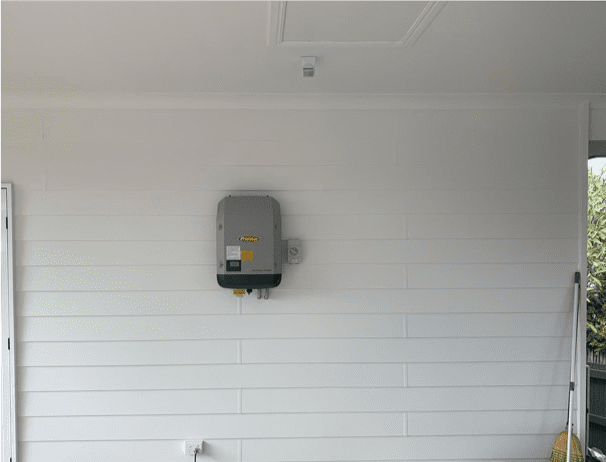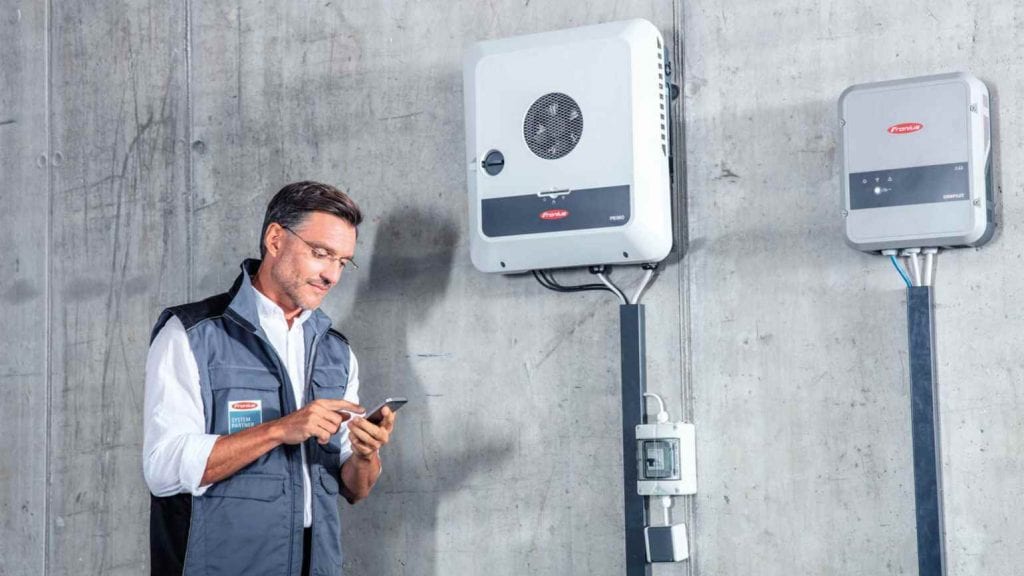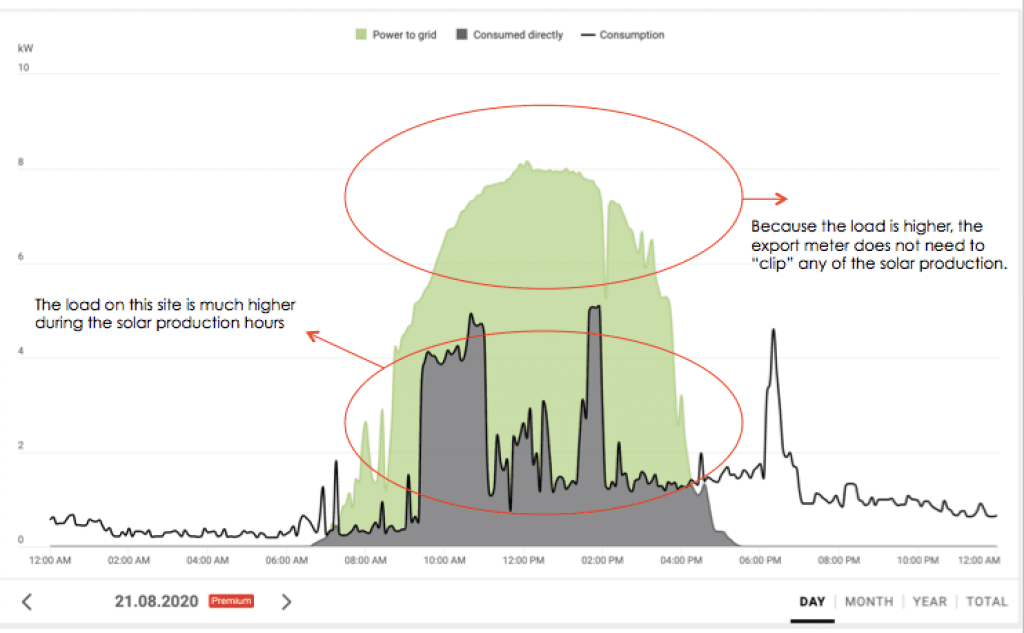Can my solar inverter be installed outside?
Your inverter is a crucial part of your solar system, and many people wonder if their inverter can be installed outside. It is extremely important to choose a good product and also have it installed correctly, in the best possible place. There are pros and cons of all major inverters brands to consider before choosing the right one for you.
Most solar inverters can be installed outside, but it is recommended you install them inside if possible. If having them inside is not possible, they should be out of the elements.
There are many other things to consider aside from exposure to weather when choosing where to install your solar inverter. Details below.

The image above shows a Fronius inverter installed in a carport, which is out of the weather.
Where should I install my solar inverter?
Installing your solar inverter outside isn’t recommended. As mentioned above, ideally you should have your solar inverter installed inside somewhere. For homes, this usually means near a sub board, which in modern homes are often in the garage. A sub board is a board that has circuit breakers for all the different circuits in your house. Your solar inverter can connect to this board as it will already be connected to the main switch board, which is where your meters are usually read. For businesses, you may have multiple sub boards and your CEC designer will need to calculate the cable runs between each board and the main switch board to work out the best possible location for your inverter(s). There are other things to consider with a commercial design such as network protection and export control as well.
If you cannot install the solar inverter inside, we would look for an area close to the main switchboard that is not exposed to the elements. Most inverters are rated at least IP56 which means they can technically be anywhere outside, and you will not usually void a the warranty of your solar inverter by installing it outside, totally exposed to the elements. However, significant sunshine beating down on the case of the inverter will wear the materials down over the years. Additionally, if your inverter is in the sun and it gets really hot, it will operate less efficiently than a cool inverter. Furthermore, consistent rain smashing down onto your inverter during heavy rains is certainly not a good thing.
For all of these reasons we would try and find an eastern wall (to stay out of the hot afternoon western sun), with an eve or some kind of protection from direct rain and sunlight. The less exposure your inverter has to direct weather, the better 🙂

Image above shows a Fronius Gen24 hybrid inverter installed inside.
What other considerations are there for my solar inverter location?
There are a few other things to consider aside from the exposure to weather.
Locating the inverter to ensure remote Wi-Fi monitoring is possible
For homes, a key consideration is where your Wi-Fi signal is available. Connecting your solar inverter to your home Wi-Fi will mean you can monitor the solar system performance remotely from your smart device or PC. This is a really cool feature, and some people love using it! For others it is not that appealing but still a very practical feature that has lots of advantages. With a remotely monitored solar array, you can always tell if the solar is performing as it should. If there ever is an issue with poor performance and a failure with a product, it can often be diagnosed remotely which saves time and money getting someone out to the property. An easy way to check the strength of your Wi-Fi signal is to stand at the potential inverter location with your smartphone and connect to the Wi-Fi network. You can then just use your phone to see what the strength of the signal is. Your inverter will require a fairly strong signal to ensure a consistent flow of data.
For larger commercial solar systems, we would usually use a 4G sim card to monitor the solar performance, so the Wi-Fi signal is less important. This is not always the case but often with commercial buildings the inverter location is not nearby an office or other area that typically needs a Wi-Fi signal. Using a 4G sim card is more expensive as there are ongoing data fees, but sometimes preferred so there are no issues with existing firewalls or other internal internet security.

The image above shows a screenshot from Fronius Solarweb monitoring platform connected to an inverter via WIFI.
Distance from switchboards – efficiency and cost
The further away from a sub board or main switch board your inverter goes, the less efficient it can be. There are many variables here and often you can easily increase the cable size running back to the board to solve the efficiency problem. However, long cable runs and bigger cables means more cost so it is always better to keep your inverter near a board if possible.
Aesthetics – what does a solar inverter looks like and where should I put it?
As solar designers, our primary job is to design the most efficient solar system possible. With this in mind, the aesthetic side of where inverters and solar panels are located is always secondary. However, we also understand that your home is where you live, and you want to make sure you are not installing an eyesore.

The image above shows 4 popular inverter brands from left to right: Sungrow, Fronius, FIMER and SMA.
As mentioned above, your inverter will usually be installed near a sub board or main switch board. When the inverter is installed outside, they are not usually very visible form the roadside of properties. For homes, the inverter will most likely be in a garage, or along the side of the house near the meter box. For businesses, the inverters will also be near a sub board or main switch board. These are rarely located in areas where staff or clients will frequently be around. If the aesthetics are extremely important to you and the location of the inverter has to be in an area where it will be seen frequently, you can build a small enclosure to surround the inverter as long as it is well ventilated and not fully enclosed. If you are considering this, you should always check the manufacturers requirements and local installation standards for clearance as you run the risk of voiding warranties or breaching safety standards by installing a non-compliant enclosure.
Will there be external conduit if my inverter is installed outside?
We will always try to avoid running external conduit (conduit is basically the case around cables) where possible. However, especially with two story homes, this is not always possible. If aesthetics is important to you and you do not like the look of external conduit running down the wall of the house, then make sure you discuss this with your solar installer. While this may be able to be minimised, sometimes it is necessary in order to create an efficient solar array.
Summary:
The location of your solar inverter is important on a few levels: efficiency, longevity, aesthetics and practicality. In an ideal world, all home inverters will be right next to a sub board inside a garage and all business inverters will be right next to the main switch board inside somewhere. However, this is not always possible, so being flexible with the design and getting as close to this perfect arrangement as possible is always our target.
Here are some other links you may find helpful:










